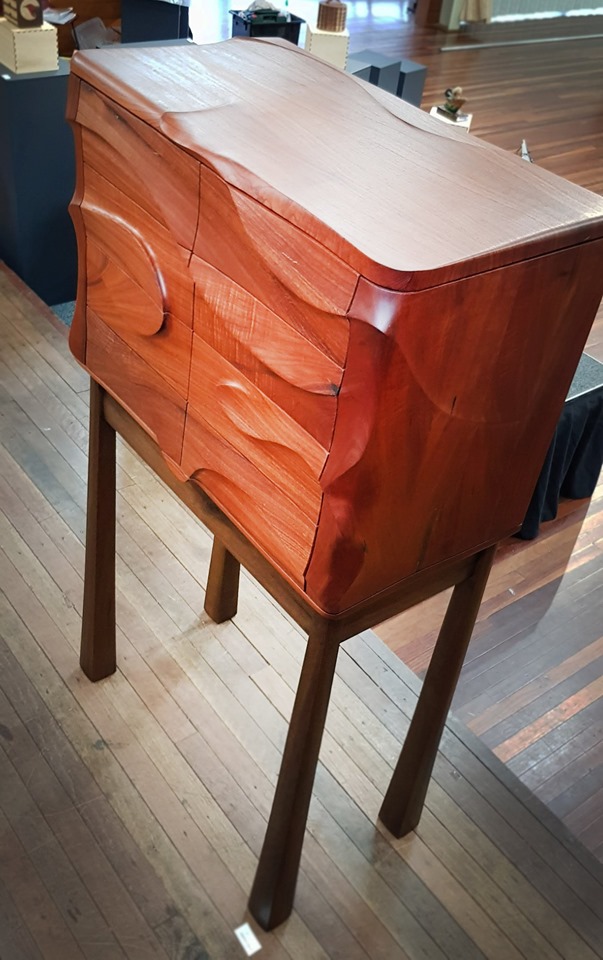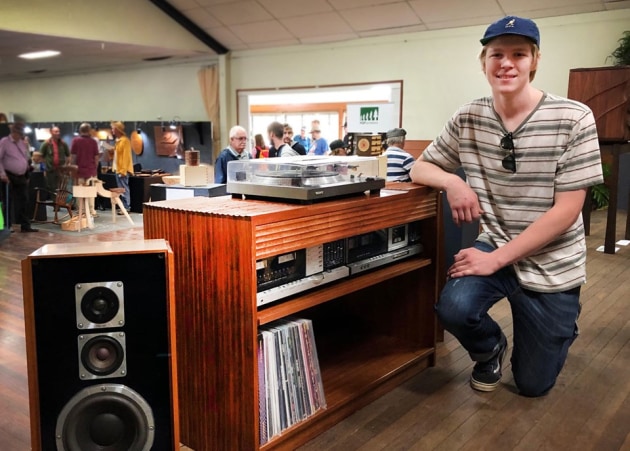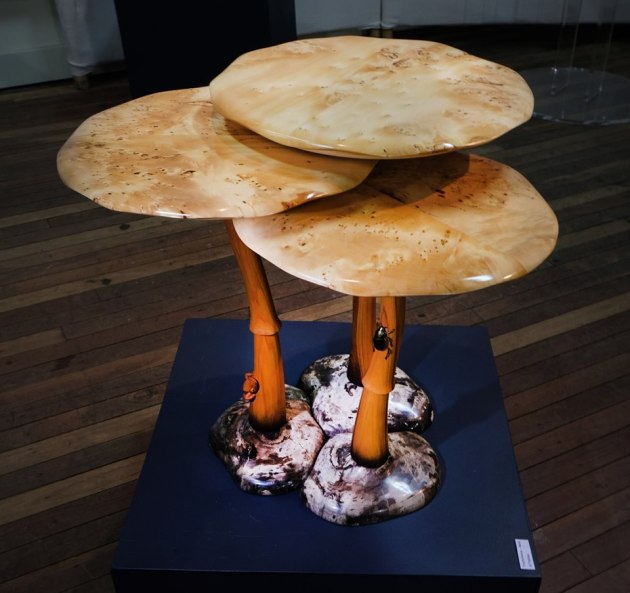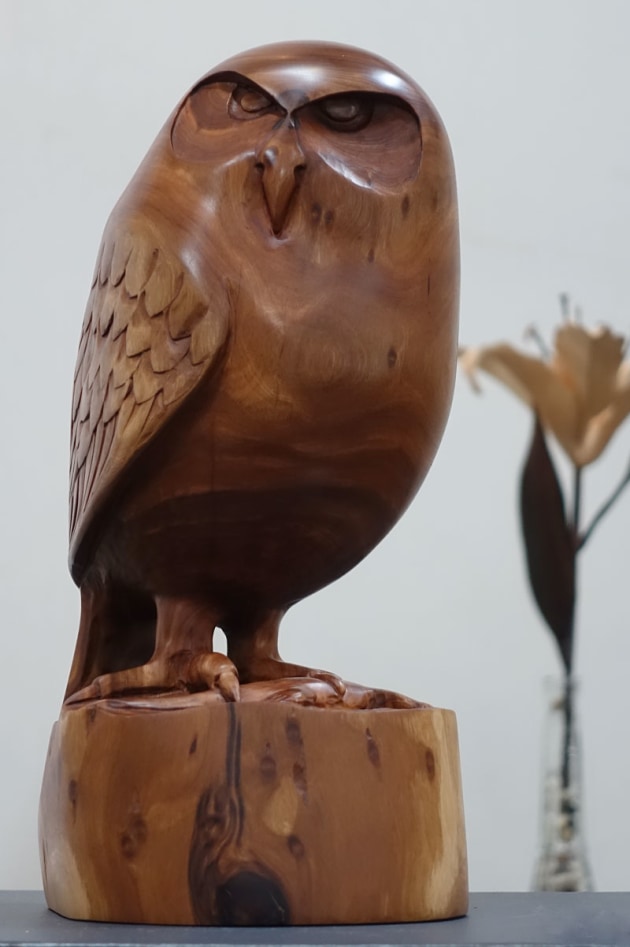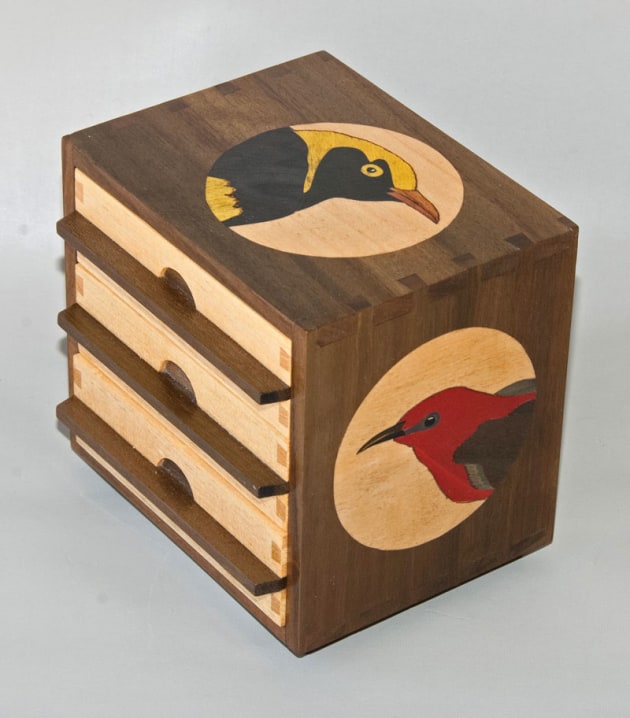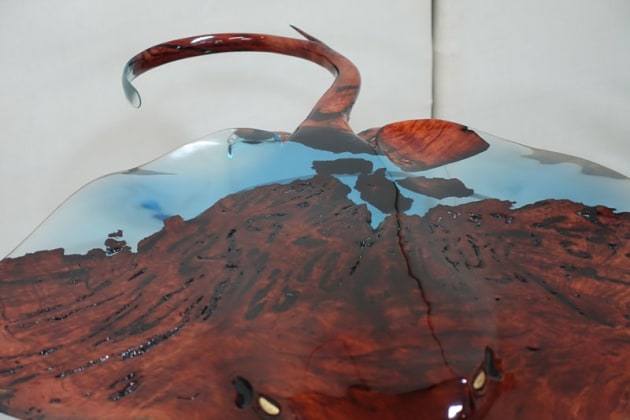-

Wootha Prize 2019 exhibition installation.
-

Wootha Prize 2019 First Prize Winner (Open), William Bayliss, The Torrent Hi-Fi Cabinet and Speakers, blackwood. "The Torrent Hi-Fi Cabinet and Speakers are made to display vintage hardware tastefully in a contemporary style. The piece is made from figured Tasmanian blackwood in both re-sawn veneer and solid timber sections with timber movement in mind. The fluting along the radius that is carried on through the top highlights the curved sides of the cabinet. Furniture as well as music both can evoke emotion and can also be enjoyed as an experience."
-

Wootha Prize coordinator Corrie Wright stands with the 2019 exhibition installation.
-

Wootha Prize 2019 First Prize Winner (Open), William Bayliss, The Torrent Hi-Fi Cabinet and Speakers, blackwood. "The Torrent Hi-Fi Cabinet and Speakers are made to display vintage hardware tastefully in a contemporary style. The piece is made from figured Tasmanian blackwood in both re-sawn veneer and solid timber sections with timber movement in mind. The fluting along the radius that is carried on through the top highlights the curved sides of the cabinet. Furniture as well as music both can evoke emotion and can also be enjoyed as an experience."
-

Vince Rush, Dawn at Laura Station, jacaranda.
"This platter is an attempt at capturing the thrill and colour of an inland dawn at Barcaldine Queensland 2018. A cold dark night turns into the warmth and colour of sunrise over the rippling waters of the wetlands at Lara station. Jacaranda was turned with 33 beadings, then chip carved and coloured with inks and finished."
-

Trevor Irvine, Spiral Mirabilis, Huon pine, Huon pine burl. "Spiral Mirabilis (wonderful spiral) mirrors the growth spiral embodying the dynamic principles of regeneration and symmetrical and balances growth in nature. This sculpture is a replica of a fossil, which may have existed millions of years ago as a living organism. Looking through the window of time, who will read the vestiges of our lives, our waste and spoilage, in the stones made from our bones. Life has many choices and every move we choose impacts the future. Events such as sudden temperature changes, tidal waves, earthquakes, floods, wildfires and acid rain are creating modern day fossils the shape, colour and form of which can only be imagined. Spiral Mirablis is designed to be a reminder of the small part humans play in this evolutionary process."
-

Tom Black, The Mason, white beech, red cedar. "The Mason is a tribute to several ancestors who were masons and cabinetmakers. Masons were the multi-skilled designers and builders of their era. Evidence of the quality and longevity of their work is all around us. With todays technology many professions and trades have taken the place of the masons and the hope is that this carving will briefly illustrate their worth."
-

Wootha Prize 2019 exhibition installation.
-

Jade Lobenstock, Serenity, bunya. "I first discovered my love of timber and woodcarving around 10 years ago, when I picked up a little piece of beech and a small file and started carving a face...a smile. Then I was generously gifted a set of chisels and everything clicked. Largely self-taught, I go by feel. Starting with selecting the piece of timber...it needs to "speak" to me; show me a glimpse of it's magic, it's potential. I only work with ethically sourced timber, and prefer a natural finish that actually feeds the wood, bringing out the beauty in the grain. I mainly carve smiling faces, loving the effect they have on the person viewing them. In this fast-paced world, my aim as an artist is to bring a slow smile to the face (and to the heart!) of the viewer. That to me is success."
-

Tim Wilson, Animal Chair, rose gum. "I worked with a chainsaw artist to produce this modern design of a reading chair carved from a solid stump. The concept stems from my exploration of animalistic forms with a range of hand made ceramics, where I have tried to create a stronger bond between a product and the consumer as if it were a pet, so that it may be taken care of for generations. In contrast to the cheap and unreliable furniture most Australians buy each year, I wanted to create a chair that not only looked durable but would actually last a lifetime while still being made from sustainable materials. The underlying goal was to get people to look differently at everyday objects like furniture, so that we might be able to change our wasteful consumerist habits, which are ingrained in our modern culture."
-

Shari Wright, Dreamboat, Huon pine, walnut, rosewood (Tiny Treasures). "The Dreamboat is a tiny elaborately carved boat, decorated with silver and gold-smithing and set with precious gems . The boat contains everything I would consider a perfect outing in a little boat would hold."
-

First prize winner, Tiny Treasures, Robin Cromer, ACT. Queensland Tribute, Qld walnut veneer, silver ash. "Maleny is pure Queensland so a tribute to the state seemed to be an appropriate for this small drawer unit. Three iconic symbols of the state were featured in marquetry: The regent bowerbird, the scarlet honeyeater and the Cooktown orchid.
The timbers also had to represent Queensland so some Queensland walnut (recycled) and silver ash were used. The drawers are lined in black suede pigskin and were made relatively 'loose' to allow for expansion as the piece would travel from a dry Canberra environment to a more humid one in Queensland."
The back of the piece and the underside of the drawers’ feature figured Queensland walnut veneer; as the 'show side' of shop-made three-ply (1.8 mm thick).
-

Shane Christensen, Battle of the Bees, white beech, acrulic, plastic native bee honey frame. "The castle design was inspired by the social structure of stingless bees (Tetragonula sp.), with princesses, a reigning queen and the natural phenomenon of fighting swarms, (epic bee battles). Tetragonula, stingless bees often fight with neighbouring hives, sometimes the defending hive will be killed, and taken over by an invading colony. It is believed there is an abundance of food and renewable resources for all the bees to live in harmony. So why fight, kill and colonise? While working on this piece, I also discovered a hollow log, with three beehives inside the same hollow, three different species coexisting. My question is, can we as humans coexist or not, don’t we also have an abundance of food and renewable resources? Are we or are we not, more intelligent than a colony of fighting insects?
To bee, or not to bee?"
-

Simon Begg, Hopping Around, kauri pine, black paint. "Hopping around is based on an old tradition of German ring turning. My goal is to modernise the technique so that it’s more than a production method but a piece of art. The image of the kangaroo shows the Australian perspective to a German process. The ring is made on the lathe with very accurate measurement and fine guesswork. The silhouette of the kangaroo was not seen until six hours after the process was started. Once the cuts are made to reveal the shape, there are no more modifications made. It’s a challenging process but very rewarding when it works out."
-

Highly commended: Murray Douglas, Southern Boobook, budgeroo. "My idea was that the skink under the talons is hoping if it stays still the owl won't know it's there or will see something better to eat. The budgeroo was salvaged from a branch from a tree cut on a fence line. This rare and beautiful timber grows in the sandstone ranges of Queensland and was once used for fence and yard posts, although it is way too valuable for that. Hopefully going forward it will be selectively harvested for carving and high quality furniture. The harsh conditions and poor soil in which it grows make it slow growing and give it a very attractive grain. The native ebony for the skinks eye was from a dead branch found on our property."
-

Donald Wright, Huon pine, walnut (Tiny Treasures). Inspired by medieval warriors carved from Huon pine and walnut adorned with precious gems, gold and silver.
-

Lee Waller, Indicolite Embrace, mallee burl, Eucalyptus dumosa (Tiny Treasures). "This piece of jewelry features a deep blue tourmaline that fades to a deep purple at its three perfect terminations. This crystal has been sculpted into the embrace of three arms of Mallee burl that have been hand carved with knives, hand-sanded and finished with linseed oil.
I have always been fascinated by the connections between things, always seeking ways to merge that which might at first seem incompatible."
-

Guy Breay, Forest Fantasy, old flame sheoak. "On the floor of the forest, an old vine clings to life with gnarled roots. Younger vines twist upward and merge into two strands at the top of the forest. At this point, they arch over under their own weight and remain in suspension. Look carefully and you may get a fleeting glimpse of a fairy dangling by her feet. Her hair flows down to the forest floor to continue the cycle of life."
-

Bruce Gilchrist, Huon Hall Table, Tasmanian Huon pine, salvaged from Lake Pedder, inlay of red cedar leaf.
-

Donald Harvison, The Essence of Spring, red cedar, Norfolk Island pine. "My piece depicts a hummingbird about to taste the sweet nectar of its favourite flower being the blossom of the red trumpet vine. Nestled above the flowers amongst entwined leaves rests a busy young butterfly. With this sculpture I have created some realism using different shades of a particular wood stain. My carvings follow the natural flow of the timber's grain and shapes to produce a gentle and artistically flowing sculpture with distinct wildlife forms emerging from the sculptured lines and spaces."
-

Second Prize Winner: Alby Johnston, Tricholoma nest of tables (detail). This is a commission piece for a private collection housed in Sydney. During the concept development the clients presented a photo of some mushrooms growing in their garden. Coincidently my favorite concept drawing was a cluster of mushroom like tables. When presented with the drawing, straight after showing me the photo, the clients loved the idea and it was clear the design direction was set. Each table is set upon a base of petrified wood. When positioned together the tables create a dynamic cluster, while separating them allows an independent presence and function as a small, delicate side table.
-

Donald Powell, The Lady and the Panther, walnut, white beech, silver.
"Thinking about Cleopatra and the lions and about the huntress Diana inspired me to this project. Carving faces,figures and animals is my speciality and added to this is a particularly vivid imagination which I strive to bring to life in my work. I see The Lady and the Panther as a sensual figure commanding a graceful and powerful animal.
-

Popular Choice winner: Josh Marks, Flight, redgum burl, epoxy resin, acrylic. "I wanted to celebrate the marriage of ocean and earth within the form of a sculptural piece. The ocean is represented by the resin, the earth represented in the redgum burl. The transparent nature of tinted epoxy resin allows light and shadow to play an additional role in how the sculpture interacts with them."
-

Michael Quinn, Native Eagle, rosewood (Tiny Treasures). "Travelling 1000km a week through the Australia bush for work I have seen so many amazing things. From wedge eagles feasting on road kill to peacock standing at the side of the road with all there feathers out and proud it’s not hard to get inspiration and then there’s the timber. I drive through farming land were there are trees poisoned for ready for racking and burning; mostly for cattle farming, some for cotton. My wife has often told me that I can’t save every tree and re-purpose it all. With the time that I spend away from home I try to put it to good use so I always carry my knives and files with me. Mostly working with hand tools and what I see for inspiration that day, nights are spent carving."
-

Donald Powell, The Lady and the Panther, walnut, white beech, silver.
"Thinking about Cleopatra and the lions and about the huntress Diana inspired me to this project. Carving faces,figures and animals is my speciality and added to this is a particularly vivid imagination which I strive to bring to life in my work. I see The Lady and the Panther as a sensual figure commanding a graceful and powerful animal.
-

Jack Wilms, Nature's Performance at the Opera House, red cedar.
"Progress means advancing towards a more desirable form. The artist's depiction of how nature will always prevail."
-

Gary Field and Lindsay Muir, Tension and Flow, red cedar, earthenware. "Desert to Rainforest: As artists we endeavour to reveal the tension, flow and diversity of the Australian landscape.
The rainforest being represented by the bowl carved from rare red cedar burl and the desert characterised in clay by the black headed python."
-

Dean Matthysen, Blooming Lily, paper bark. A lily in bloom carved from paper bark and ebonised timber flooring offcuts.
-

Second Prize Winner: Alby Johnston, Tricholoma nest of tables (detail). This is a commission piece for a private collection housed in Sydney. During the concept development the clients presented a photo of some mushrooms growing in their garden. Coincidently my favorite concept drawing was a cluster of mushroom like tables. When presented with the drawing, straight after showing me the photo, the clients loved the idea and it was clear the design direction was set. Each table is set upon a base of petrified wood. When positioned together the tables create a dynamic cluster, while separating them allows an independent presence and function as a small, delicate side table.
-

Allison Woods, The Pomona Handbag, camphor laurel, Australian red cedar, leather. The design is based on the shape of a pear, a very feminine and pleasing shape. The name was influenced by Greek, Roman and Italian mythologies where the goddess Pomona, watched over and protected trees and cared for their cultivation and the pear was also an influential item in these mythologies.
It also reflects the name of an area on the Sunshine Coast.
This handbag gives the elegant woman not only an eye catching fashion statement, but also a unique functional piece to hold personal items and it will complement any outfit for any occasion.
-

Second Prize Winner: Alby Johnston, Tricholoma nest of tables (detail). This is a commission piece for a private collection housed in Sydney. During the concept development the clients presented a photo of some mushrooms growing in their garden. Coincidently my favorite concept drawing was a cluster of mushroom like tables. When presented with the drawing, straight after showing me the photo, the clients loved the idea and it was clear the design direction was set. Each table is set upon a base of petrified wood. When positioned together the tables create a dynamic cluster, while separating them allows an independent presence and function as a small, delicate side table.
-

Third Prize Winner: Broc Cattley, Jewellery Stand, Qld red cedar, quandong (ebonised), recycled hardwood base. "This piece was inspired from the natural flowing forms we see in nature. I wanted to design a piece of furniture that makes you want to run your hand over it every time you see it, to create changing shadows as the light in the room changes through the day."
-

Bevan Blackshaw, The Book Bird (Tiny Treasures), Vic ash, camphor laurel. "My Book Birds make one handed reading easy. The pointed part engages with the spine of the book and the wings hold the pages open. The hole can be sized to fit most thumbs. I generally make these in four sizes so they fit a wide range of thumbs. Best fit is up to the first knuckle of the thumb. They came about as a way to use a regular piece of workshop scrap and small off cuts from other work thus creating a product from potential landfill."
-

Brian Dawson, Composite Ring Box, jarrah, Huon pine, silky oak, myrtle (Tiny Treasures). 'I aim to present a visually engaging selection of Australian timbers displayed in an unusual and distinctive way. I try to avoid straight lines and rectilinear forms and aim for a sculptural, organic shape with no straight lines and with verticals and horizontals slightly askew to mimic a natural, growing form. The timbers are glued to form a sandwich, bandsawn in an uneven oval and then the central section is removed using a bandsaw. The bandsaw is again used this time to cut horizontally into uneven layers each of which is carefully sanded to form rounded, organic form. The layers are glued together and tops and bottoms are finally added."
-

Noel Bradley, Jules of the Sea. As a lover of animals especially tropical fish I wanted to create an underwater scene, which involved the vibrant colours of the sea life in their natural environment, surrounded by colourful corals and rock formations. I wanted to create a piece that stood out that caught people’s attention that was big and depicting what our underwater world has to offer.
-

Neal Wright, Late Night Wine, pink gidgee, doughwood, Qld ebony, conkerberry (Tiny Treasures). The components for this one-thirtieth scale ensemble were turned with handmade tools under a magnification lamp. The timbers were all salvaged.
